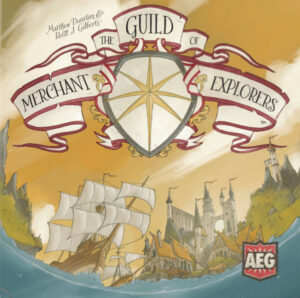 These weeks, nay months, have been filled with arduous travel and untold treachery. Our team charts their course at every turn, through grasslands, mountain regions, and deserts. Even the waters, which are abundant and vast, pose difficulties. We were called upon by her majesty to voyage far and wide, to discover new locales and riches, to establish trade, and create villages. We have seen much these days and hope our return will provide the glory the Queen desires.
These weeks, nay months, have been filled with arduous travel and untold treachery. Our team charts their course at every turn, through grasslands, mountain regions, and deserts. Even the waters, which are abundant and vast, pose difficulties. We were called upon by her majesty to voyage far and wide, to discover new locales and riches, to establish trade, and create villages. We have seen much these days and hope our return will provide the glory the Queen desires.
The Guild of Merchant Explorers is designed by Matthew Dunstan & Brett J. Gilbert and is published by AEG. It plays one to four players in about thirty to forty-five minutes. And what are you doing in this game of exploration? Flipping cards and filling in the map with cubes.
Gameplay Overview:
The Guild of Merchant Explorers is a game about expansion. Each player is given the same map filled with hexes of unique terrains. They are tasked with expanding influence by strategically placing their explorer cubes to create villages, plunder ruins, and discover towers. Along the way, they also strategically create trade routes and stumble upon plenty of coin.
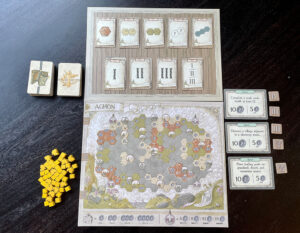
Over four rounds players flip a card from a shuffled deck that features five terrain types (mountain, grassland, desert, water, wild) and round cards. The round continues until the deck runs out. Players expand from a central capital and add cubes to hex spaces adjacent to first the capital, and then any space next to an already placed cube. When a region type is filled with a player’s cubes, one of those spaces becomes a village.
Villages are important as they remain on the map at the end of a round while all cubes are removed. This provides reach into distant lands as cubes can then be placed adjacent to them going forward. Expansion is important for several reasons. First, some hexes feature coins (which are effectively points), others feature trade routes that provide an abundance of point opportunities, and ruin hexes provide additional benefits via either immediate actions or end-game scoring.
Each game features a unique set of three goals (out of six possible options) that players may race to fulfill to receive the highest point value. Players who complete these later still score but receive fewer points. Treasure cards from ruins may also provide direction for expansion.
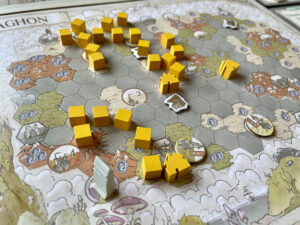
All of this is fueled by the deck of explore cards. As players are utilizing the same map design, their initial launch may look similar, but every time a new round card is flipped, players are dealt two unique investigate cards. They choose one to keep, take its powerful action, and trigger this action again in future rounds whenever the specific round card is revealed. As an example, in round three, when the round one card is flipped, players activate their round one investigate card action.
Players gain coins throughout and income increases each round for new villages, each new tower that is discovered on the edges of the map, as well as meeting goals and boosting end game scoring opportunities. The solo mode also features a way to restrict goal scoring and is of the beat-the-point-threshold type of challenge.
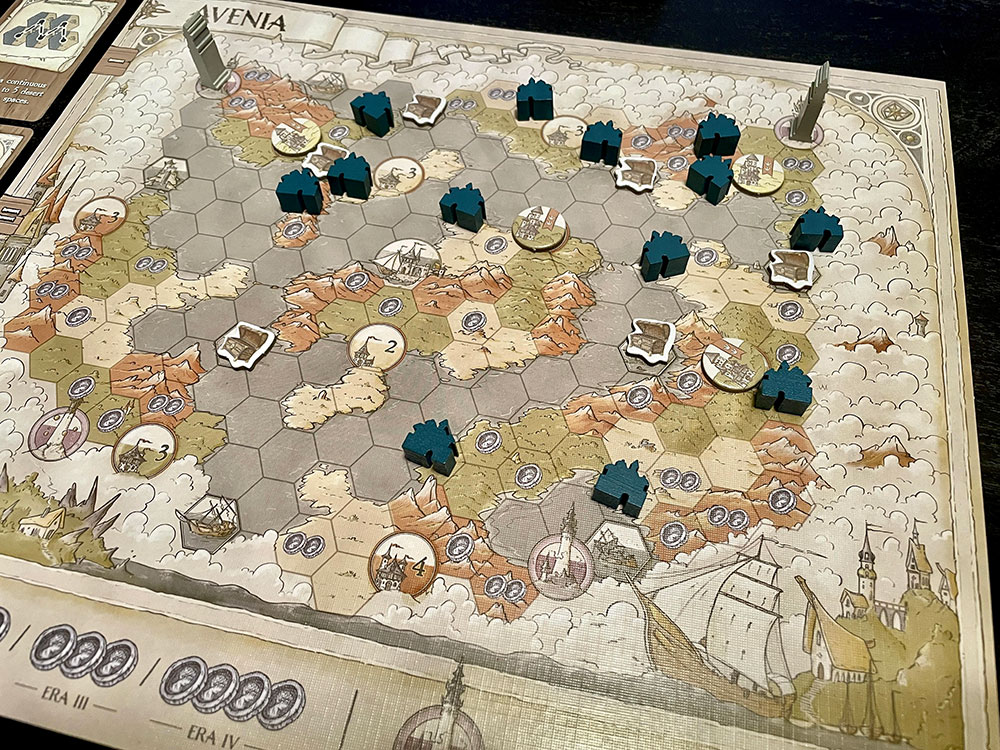
Game Experience:
After playing this game with my group, we all agreed in the end that this would make an excellent mobile app. In fact, I would own this as a mobile app and eagerly anticipate all the expanded content that is sure to come from new maps, cards, and mechanisms. This is not to distract from the physical board game, but rather to highlight some of the downfalls of the production design.
As a physical game, The Guild of Merchant Explorers presents itself as a medium weight experience, though it’s truly a larger style roll-and-write. Yes, it’s a flip-and-fill, and as such it requires more space to allow for cubes to be placed. I don’t have an issue with the size though. The issue is with the flimsy maps with their slick surfaces, as well as with the scale and coloring of the terrain. One false move will send cubes flying. And on occasion, one must lean in close to distinguish between grassland and mountain.
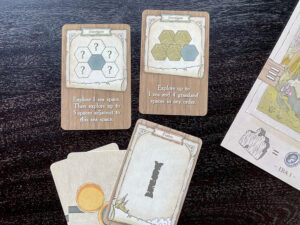
These may seem like small things, and in a way they are, but the artwork here by Gerralt Landman is quite stunning (if not muted by color choice) and it’s a shame this is restricted by the game design. This truly is a quick and easy game to play, and everything is clearly presented save for those terrain issues.
There is strategy for sure, and luck, but everything functions via the central deck of cards and the powers provided by the investigate cards. The investigate cards are the star of the show. Each one can provide an excellent boost to your exploration engine. And as each player gains new powers, their maps begin to verge into different paths and scoring starts to swing in new directions. These cards also shape strategy, provide boosts for goals, and are just a blast to trigger.
The main aspect of strategy comes in the form of route efficiency. This provides an incentive to seek out towers for major points, or to combo trade routes multiple times. Trade routes are an excellent source of points, and the game does a great job of limiting this by asking players to cover one of the two routes each time a connection is made. Another nice wrinkle is how the water terrain card works—players can only travel three spaces in a straight line. Those winds must be fierce.
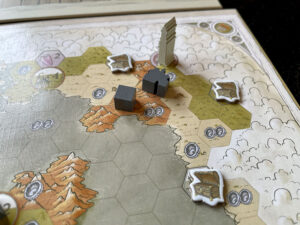
All efforts are to increase the number of coins one collects. Unfortunately, the decision to make points individual coin tokens instead of scoring tracks adds a hefty amount of gathering during turns, and as such this breaks up the nice flow of the flip and fill mechanism. When playing solo, I prefer to use a simple counter application to track my score and leave the coins in the box.
And a final note on the gameplay: while the investigate cards provide plenty of verging strategies, this is truly a multi-player solitaire game with a final score comparison, rather than a game with any interaction. The theme of exploration is further broken down by the fact that players compete on the same map and can explore the same locations for the same coin/treasure. There’s space here for player interactivity to be added to the design, but I’m certain that balance would suffer as a result.
Final Thoughts:
The Guild of Merchant Explorers is certainly unique. I prefer it as a solo experience, and with that in mind, I wonder how long this stays in the collection. Anticipation for new maps and new rules is there, but my lukewarm reaction to the base game may be something others are experiencing as well. If only there were plans to shift this design over to a mobile app. It truly could be a perfect experience in that space. On the table, it suffers from production design, fiddly token requirements, and while playing with others, it’s mostly a head-down exercise with the occasional grab at coins (which are double-sided with different values, another thing that can cause problems). In the end, the Queen may be satisfied with our exploits, but we’re left wondering if it was all worth it.
Final Score: 3 stars – A fun discovery that firmly plants its flag and yet may have wound up in the wrong land.
 Hits:
Hits:
• Asymmetric Investigate cards
• Map variety
• Exploration mechanism
• Quick playtime
Misses:
• Coin tokens disrupt flow of game
• Accidental map shifts
• Small maps create visual issues
• Solo vs. multiplayer distinction
Source: Board Game Quest





